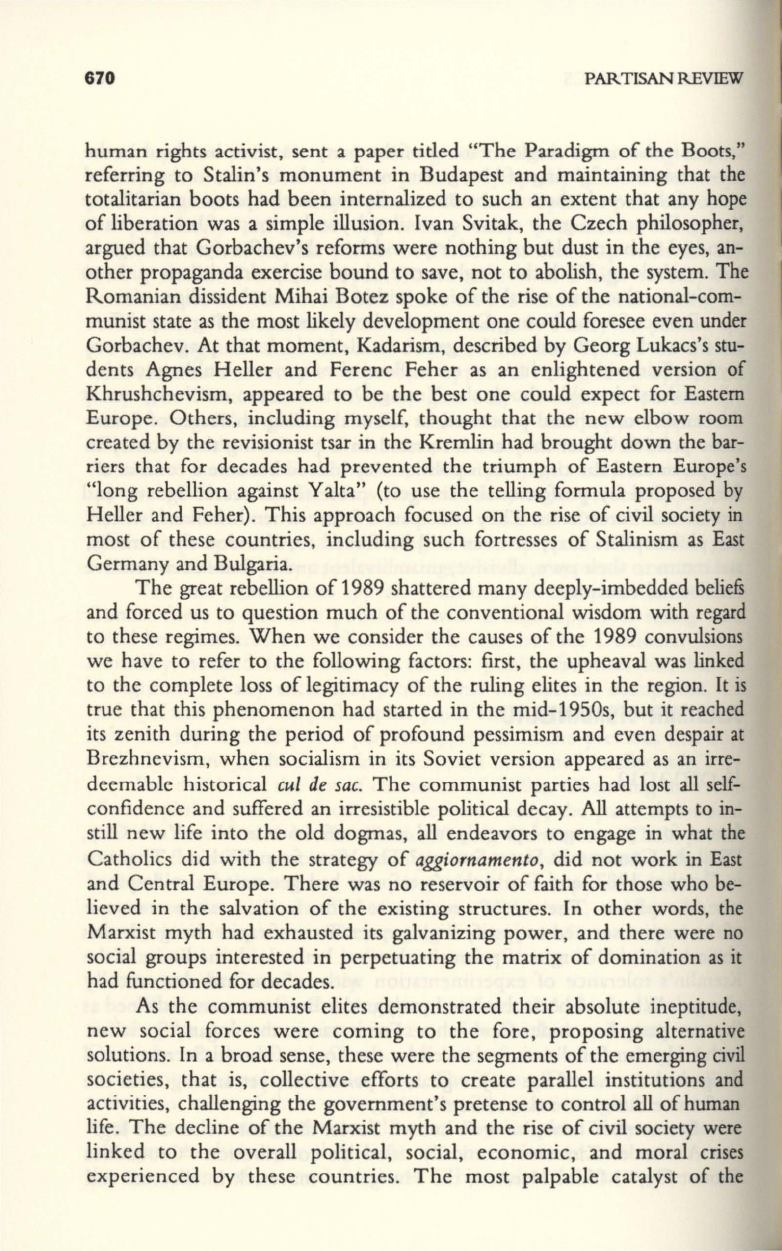
670
PARTISAN REVIEW
human rights activist, sent a paper titled "The Paradigm of the Boots,"
referring to Stalin's monument in Budapest and maintaining that the
totalitarian boots had been internalized to such an extent that any hope
of liberation was a simple illusion. Ivan Svitak, the Czech philosopher,
argued that Gorbachev's reforms were nothing but dust in the eyes, an–
other propaganda exercise bound to save, not to abolish, the system. The
Romanian dissident Mihai Botez spoke of the rise of the national-com–
munist state as the most likely development one could foresee even under
Gorbachev. At that moment, Kadarism, described by Georg Lukacs's stu–
dents Agnes Heller and Ferenc Feher as an enlightened version of
Khrushchevism, appeared to be the best one could expect for Eastern
Europe . Others, including myself, thought that the new elbow room
created by the revisionist tsar in the Kremlin had brought down the bar–
riers that for decades had prevented the triumph of Eastern Europe's
"long rebellion against Yalta" (to use the telling formula proposed by
Heller and Feher) . This approach focused on the rise of civil society in
most of these countries, including such fortresses of Stalinism as East
Germany and Bulgaria.
The great rebellion of 1989 shattered many deeply-imbedded beliefs
and forced us to question much of the conventional wisdom with regard
to these regimes. When we consider the causes of the 1989 convulsions
we have to refer to the following factors: first, the upheaval was linked
to the complete loss of legitimacy of the ruling elites in the region. It is
true that this phenomenon had started in the mid-1950s, but it reached
its zenith during the period of profound pessimism and even despair at
Brezhnevism, when socialism in its Soviet version appeared as an irre–
deemable historical
cui de sac.
The communist parties had lost all self–
confidence and suffered an irresistible political decay. All attempts to in–
still new life into the old dogmas, all endeavors to engage in what the
Catholics did with the strategy of
aggiornamento,
did not work in East
and Central Europe. There was no reservoir of faith for those who be–
lieved in the salvation of the existing structures. In other words, the
Marxist myth had exhausted its galvanizing power, and there were no
social groups interested in perpetuating the matrix of domination as it
had functioned for decades.
As the communist elites demonstrated their absolute ineptitude,
new social forces were coming to the fore, proposing alternative
solutions. In a broad sense, these were the segments of the emerging civil
societies, that is, collective efforts to create parallel institutions and
activities, challenging the government's pretense to control all of human
life. The decline of the Marxist myth and the rise of civil society were
linked to the overall political, social, economic, and moral crises
experienced by these countries. The most palpable catalyst of the


